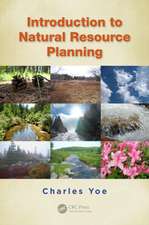Crop Stress and its Management: Perspectives and Strategies
Editat de B. Venkateswarlu, Arun K. Shanker, Chitra Shanker, M. Maheswarien Limba Engleză Paperback – 28 ian 2014
| Toate formatele și edițiile | Preț | Express |
|---|---|---|
| Paperback (1) | 1232.41 lei 6-8 săpt. | |
| SPRINGER NETHERLANDS – 28 ian 2014 | 1232.41 lei 6-8 săpt. | |
| Hardback (1) | 1236.99 lei 6-8 săpt. | |
| SPRINGER NETHERLANDS – 23 noi 2011 | 1236.99 lei 6-8 săpt. |
Preț: 1232.41 lei
Preț vechi: 1502.94 lei
-18% Nou
Puncte Express: 1849
Preț estimativ în valută:
235.85€ • 256.10$ • 198.11£
235.85€ • 256.10$ • 198.11£
Carte tipărită la comandă
Livrare economică 22 aprilie-06 mai
Preluare comenzi: 021 569.72.76
Specificații
ISBN-13: 9789400798540
ISBN-10: 9400798547
Pagini: 628
Ilustrații: XVI, 612 p.
Dimensiuni: 155 x 235 x 33 mm
Greutate: 0.87 kg
Ediția:2012
Editura: SPRINGER NETHERLANDS
Colecția Springer
Locul publicării:Dordrecht, Netherlands
ISBN-10: 9400798547
Pagini: 628
Ilustrații: XVI, 612 p.
Dimensiuni: 155 x 235 x 33 mm
Greutate: 0.87 kg
Ediția:2012
Editura: SPRINGER NETHERLANDS
Colecția Springer
Locul publicării:Dordrecht, Netherlands
Public țintă
ResearchCuprins
Preface.- 1. Overview of plant stresses: Mechanisms, adaptations and research pursuit; Maheshwari. M. et al.- 2. Dryland Agriculture: Bringing resilience to crop production under changing climate; Venkateshwarlu B., Arun K.Shanker.- 3. Abiotic and biotic stresses in Plantation Crops: Adaptation and Management ; Vinod K.K.- 4. Enhancing productivity and performance of oil seed crops under environmental stresses; Bhinu V.S. et al.- 5. Applications of Machine Learning for Maize Breeding for stress; Leonardo Ornella et al.- 6. Heat stress in rice – physiological mechanisms and adaptation strategies; Kondamudi R. et al.- 7. Improvement of drought resistance in crops:From conventional breeding to genomic selection; Anna Maria Mastrangelo et al.- 8. Plant response and tolerance to abiotic oxidative stress: antioxidant defense is the key; Mirza Hasanuzzaman et al.- 9. Transcription Factors and Genes in Abiotic Stress; Pasqualina Woodrow et al.- 10. Chlorophyll a fluorescence in abiotic stress;Lucia Guidi, Elena Degl’Innocenti.- 11. Crop Stress and Aflatoxin Contamination: Perspectives and Prevention Strategies; Baozhu Guo et al.- 12. Role of Ethylene and Plant Growth-Promoting Rhizobacteria in Stressed Crop Plants; Baby Shaharoona et al.- 13. RNAi: Machinery and role in pest and disease management; Surekha Agarwal et al.- 14. Conservation Biology; Chitra Shanker et al.- 15. Postharvest biocontrol - New concepts and application; Neeta Sharma et al.- 16. Remote Sensing of Biotic Stress in Crop Plants and its Applications for Pest Management; M. Prabhakar et al.- 17. Nematode Pathogens of Crops: Consequences of Climate Change; Nethi Somasekhar, Prasad J.S.- 18. Socio Economic and Policy Issues in Abiotic Stress Management; Kareemulla K., Rama Rao C.A.- 19. Changing roles of Agricultural Extension: Harnessing Information and Communications Technology (ICT) for adapting to changing climate; Shaik N. Meera et al.- Index.
Notă biografică
Textul de pe ultima copertă
Crops experience an assortment of environmental stresses which include abiotic viz., drought, water logging, salinity, extremes of temperature, high variability in radiation, subtle but perceptible changes in atmospheric gases and biotic viz., insects, birds, other pests, weeds, pathogens (viruses and other microbes). The ability to tolerate or adapt and overwinter by effectively countering these stresses is a very multifaceted phenomenon. In addition, the inability to do so which renders the crops susceptible is again the result of various exogenous and endogenous interactions in the ecosystem. Both biotic and abiotic stresses occur at various stages of plant development and frequently more than one stress concurrently affects the crop. Stresses result in both universal and definite effects on plant growth and development. One of the imposing tasks for the crop researchers globally is to distinguish and to diminish effects of these stress factors on the performance of crop plants,especially with respect to yield and quality of harvested products. This is of special significance in view of the impending climate change, with complex consequences for economically profitable and ecologically and environmentally sound global agriculture. The challenge at the hands of the crop scientist in such a scenario is to promote a competitive and multifunctional agriculture, leading to the production of highly nourishing, healthy and secure food and animal feed as well as raw materials for a wide variety of industrial applications. In order to successfully meet this challenge researchers have to understand the various aspects of these stresses in view of the current development from molecules to ecosystems. The book will focus on broad research areas in relation to these stresses which are in the forefront in contemporary crop stress research.
Caracteristici
Main objective is to deliver information for developing strategies to combat crop stress Bridges the mechanistic aspects (what do we know) of stresses with the strategic aspects (what do we do) Presents both abiotic and biotic stresses in a single volume







